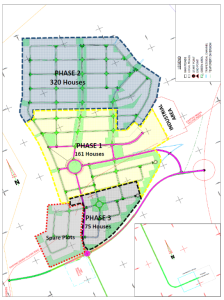Quitunda Village
Quitunda Village is the new community constructed for households affected by physical displacement. In addition to the replacement houses provided to physically displaced households as part of their compensation package, the village includes public infrastructure, services and utilities. Together this includes a government office for the administrative post, a community center, places of worship (including mosques and a church), a community marketplace, a primary school a Type II Health Center, a police post, a bus exchange, a water system and power supply.
Village design characteristics
The design and layout of Quitunda Village was established after extensive stakeholder engagement consultations, consideration of local contextual factors, existing urban development models, town planning and urban design principles, and sustainable development guidelines. Our aim is to ensure the design and layout of Quitunda Village is:
- Efficient – To encourage optimal resource use and within close proximity to new or existing opportunities
- Permanent – To ensure people feel comfortable and safe in their new community and do not move back to the areas from which they came
- Sustainable – To ensure the people and the physical community are economically, socially, and environmentally cohesive
The layout for Quitunda Village includes:
- A central area for public facilities including a primary school, a Type II Health Center, government administration facilities, a police station, a marketplace, and a community center
- Leisure and recreation areas
- An access road linking the village to the R247 highway
- Internal accessways for pedestrians and vehicles via footpaths and roads
- An area dedicated for village expansion
- Water drainage paths
In line with the multi-phased resettlement approach, the construction of Quitunda Village will also be multi-phased. The village’s construction program comprises three main phases. Phase 1 includes making 161 houses available, Phase 2 includes 320 houses, and Phase 3 will complete another 75 houses. Additional housing to account for natural growth of the population will also be constructed.
Three phases of development

To date, the project operator has completed construction of all public infrastructure, services and utilities and the housing to accommodate the first 186 physically displaced households. Housing for an additional 474 households is under construction.
Village handover
The handover of the Quitunda Village from the project partners to the district government has been carefully planned. During the 24-month handover period TEPMA1 will work with the district government to ensure the ongoing operations, care, and maintenance of the village.
Replacement housing design characteristics
Adequate housing is considered a basic human right. This means housing must, at a minimum, meet the following criteria: have legal security of tenure, an availability of services, materials, facilities and infrastructure, be affordable, be habitable, provide accessibility, be safely located, and be culturally adequate.
During the design phase, TEPMA1 conducted a number of studies and consultation sessions with the affected community members and other stakeholders and a model house was built for affected-community members to view and suggest alterations for the final design of the homes.
The new homes in Quitunda Village are built with conventional materials and include the following characteristics:
- A floor constructed area of 70 m2
- Three bedrooms
- One living room
- One interior kitchen
- A space to be used as an interior bathroom in the future
- One exterior kitchen
- One exterior bathroom
- External taps with water connections
- Electricity connection to the national grid
- Polyethylene tanks for rainwater collection
To ensure security of tenure, the Mozambican Government has issued land titles (known as DUAT in Mozambique), for the physically resettled households’ new residential plots.
More about resettlement
Livelihood restoration
The new community constructed for households affected by physical displacement.
Vulnerable peoples’ program
A program that identifies, assesses and provides assistance to vulnerable households during the resettlement process.
Resettlement plan
A responsible resettlement plan to restore or improve the livelihoods of displaced people on the Afungi Peninsula.